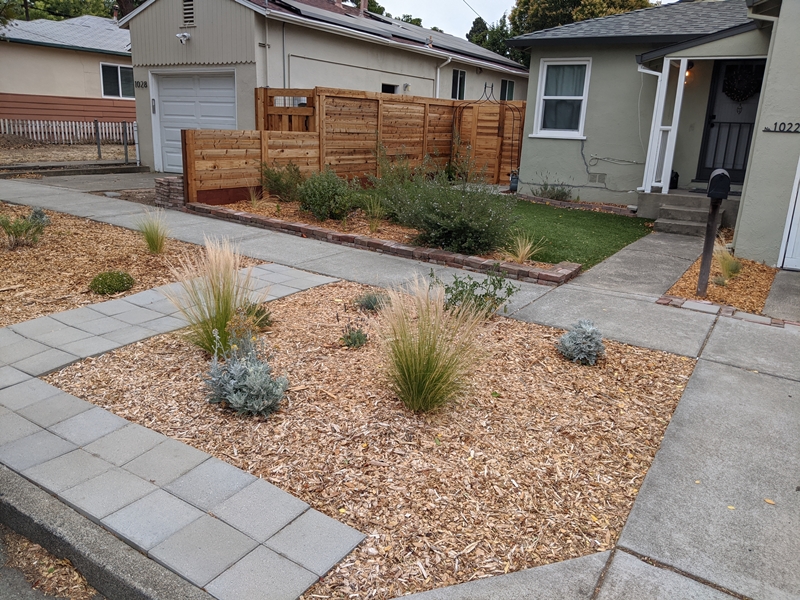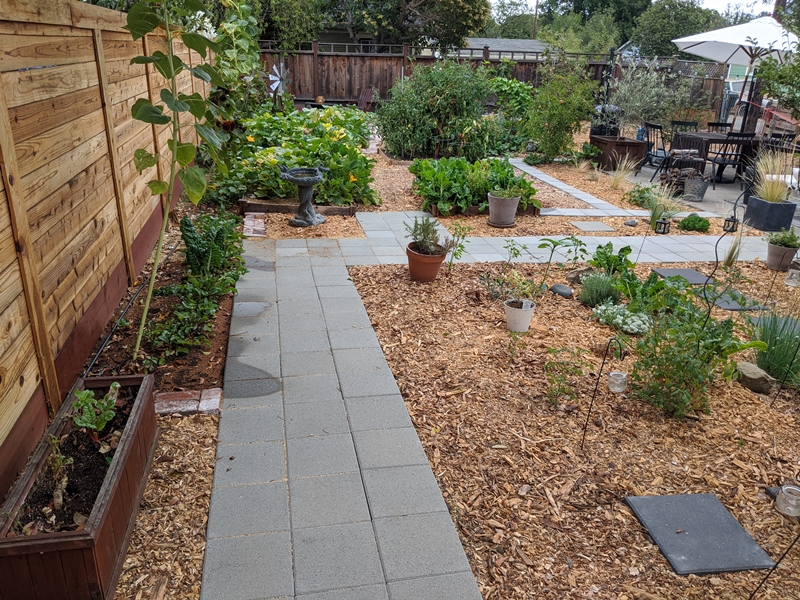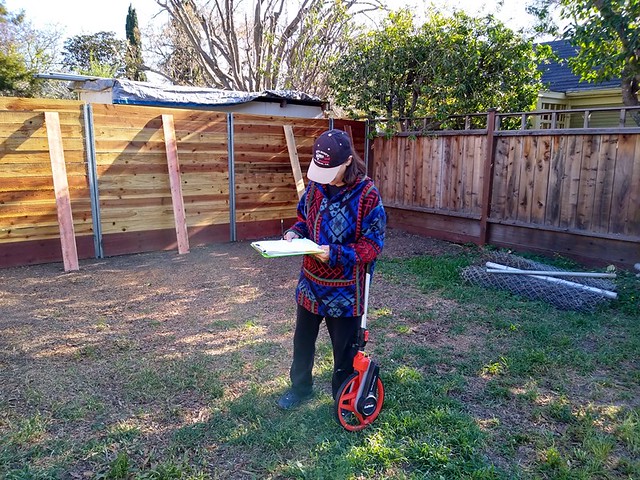Sure-Would Forest
Sure-Would Forest
Vallejo, CA
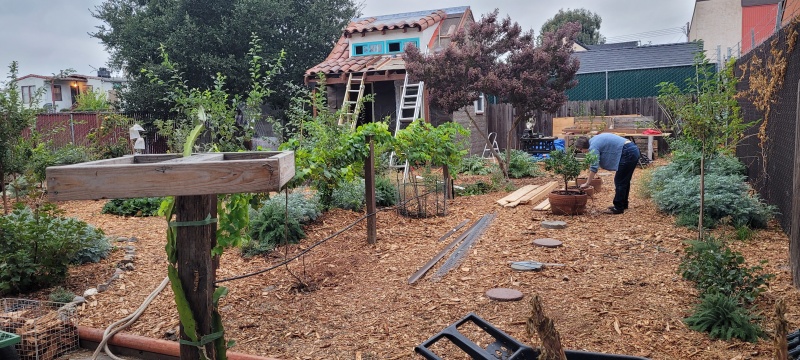
Inspiration
This garden was inspired by Sustainable Solano gardens and a love of fresh fruit. Homeowners Matthew and Emma received a nearly blank slate when they purchased the property in 2021, and soon started working on enriching the soil, retaining rain water, and laying the groundwork for a food forest.
“We sure would like fruit trees.”
“We sure would like to be more environmentally friendly.”
“We sure would like to eat more healthy and prepare more food from our garden.”
“We sure would like our backyard to feel more like a nature trail.”
“We sure would like to not have the backyard flood every year.”
Matthew and Emma had never even heard the word permaculture before starting to plant grapes and a few trees in the fall of 2021. But they soon learned about the Benicia and Vallejo Demonstration Food Forest Tour put on by Sustainable Solano and the many resources available to them. The tour provided inspiration and ideas for what grows well in the area, what they like, ideas for how to maintain and expand on what they’d started, and how to start harvesting rainwater for their garden.
In less than a year they were getting great benefits from their effort. Almost immediately they were able to add fresh herbs, vegetables, and fruits to their meals. Bio-tilling the clay with daikon radish to break it up naturally while adding nutrients to the soil, along with covering the yard in cardboard and several inches of woodchip mulch, have greatly reduced flooding and required maintenance. Adding drip irrigation has also reduced maintenance effort and water use.
In just over two years they’ve gone from food desert to food forest with the ability to eat from their garden year round.
Site Details
Installation Date:
Continued work starting in October 2021
NativeSun Gardens design installation June 2023
Size:
2500 square feet
Sun Exposure:
8 hours
Soil:
Clay, biotilled with daikon radish, amended with compost and woodchip mulch
Secondary Water:
Lawn conversion
Rainwater harvesting (1,100 gallons)
Initial Design:
Our original design incrementally evolved over time as we found more edible plants we wanted to add to the forest. The basic design constraints centered around the following:
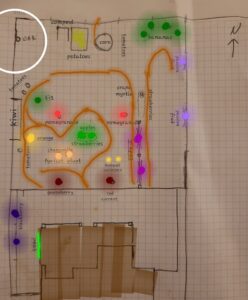 All plants should be edible or useful in some way
All plants should be edible or useful in some way- We want to be able to forage and eat from the forest year round
- We want to have minimal water use
- We want to put the work up front so that the forest is as close to maintenance free as it matures
- We want it to feel like a nature trail or park
- We want to minimize flooding in the yard and have better water management
Updated Design:
In 2023, we contacted Native Sun Gardens to help us improve on our design both aesthetically and functionally.
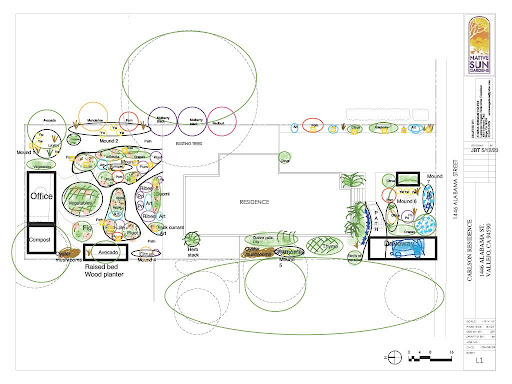
Designer: Joshua Burman Thayer, Native Sun Gardens
Plant List:
Live Oak, Crepe Myrtle, Magnolia, Lemon (New Zealand, Variegated Pink, Improved Meyer), Orange (Valencia), Honey Mandarin, Lime (Bearss, Other unknown), Kumquat (Nagami), Apples (Gala and Pink Lady), Apricot (Blenheim), Plum (Santa Rosa, Satsuma), Pluot (Flavor Supreme, Other unknown)m, Avocado (Haas), Persimmon (Fuyu), Fig (Mission, Little Miss), Mulberry, Western Redbud
Currant (Red Lake), Gooseberry (Captivator), Goumi berry (Red Gem and Sweet Scarlet), Goji berry, Rhubarb, Pomegranate (Parfianka), Strawberry Guava, Artichoke (Globe, Colorado Purple Star)
Lavender (Hidcote Giant English, Provence French), Chamomile (German), Borage, California Fuchsia, Deer Grass, Penstemon (Margarita BOP), Artemisia (Powis Castle/Wormwood/Silver Sage), Yarrow, Salvia (Pineapple Sage)
Strawberries (Sequoia), Thyme (Wooly, Creeping, Elfin, Silver, Golden Lemon)
Mushrooms (Blue Oyster, Brown Oyster, King Trumpet, Wine cap, Blewit)
Passion Fruit (x2), Blackberries (invasive), Raspberry (Latham Red, Golden), Muscadine (Triumph), Grapes (Thompson Seedless)
Installation:
The installation has been an ongoing process starting in October 2021 with planting of the first grape vines and continuing to today.
Major work was done in June 2023 by Native Sun Gardens to install the updated design and installation of drip irrigation.
Inspired by rainwater harvesting systems seen on the 2023 Demonstration Food Forest, tour Matthew and Emma bought and installed four IBC totes to collect water from their roof drains. The irrigation system for Sure-Would Forest is designed to feed from either city water or rainwater storage tanks allowing over 1000 gallons of rainwater to be used to irrigate the garden.
Vision for the Future:
We are always adjusting and finding new ways to improve Sure-Would Forest. One plan is to turn the main pathways into swales to store even more water from the rainy season in the ground. Another is to expand our use of IBC totes to capture more water and be even less reliant on city supplies.
We also hope to add a bee hive or two to the forest soon.
Inspired by this garden? Tell us about your own garden inspired by sustainable landscaping, rainwater capture, edible gardens, pollinator plants, habitat and more at info@sustainablesolano.org

